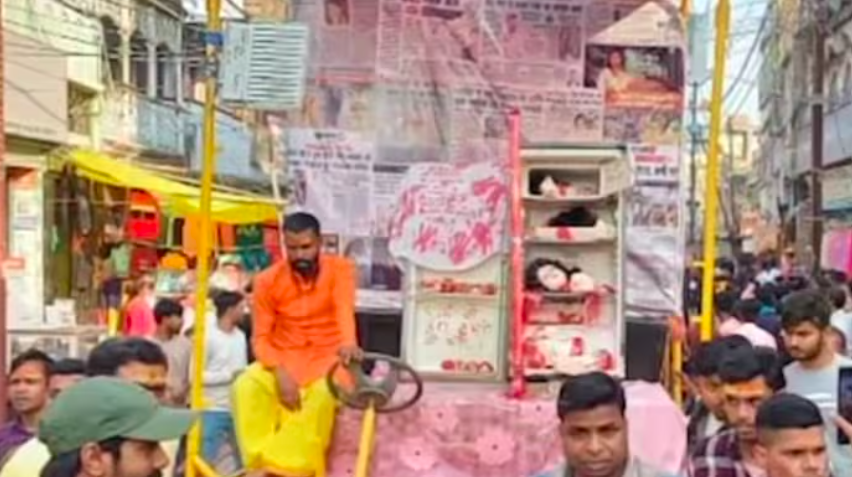The challenge thrown up by the Maoists is clearly daunting and armed response is being seen as not the only answer.
Sangita Jha
There is clear admission of the fact among the officials that heart of India, geographically speaking, is in the clutches of naxals. So much so that the state governments or even the Central agencies find difficult to reach out the means of development and advancements to tribals living in deep forest in Central India. The challenge thrown up by the naxals is clearly daunting and armed response is being seen as not the only answer.
Ever since Union minister Jairam Ramesh took charge of the Union rural development ministry, there has been a change in the approach as far as dealing wity the naxals or left wing extremism (LWE), as spoken officially, is concerned. In the last one year, it’s being seen, that the government’s approach is to deal with naxals with full force but at the same time reaching out the benefits of various Centrally sponsored schemes to the tribals in a clear strategy that they are do not fall prey to the left wing extremism ideology.
This year’s Budget proposed by the Union Finance Minister Pranab Mukherjee endorses the strategy on which Ramesh is working on in partnership with central paramilitary forces and state governments.
Mukherjee has proposed setting up of a National Rural Livelihoods Foundation (NRLF) on the lines of the Public Health Foundation on public-private partnership mode specifically for 173 districts, which are affected by the naxal violence.
While the Centre would pitch in with an initial allocation of Rs 500 crore for the first two years, another Rs 500 crores would come from the corporates and state governments. Ramesh has already a number of trusts sponsored by big corporate houses who want to be part of the exercise, indicating that funds would not be a problem. The state governments too have reasons to pitch in with their share for the objective of setting up of NRLF.
The idea of the NRLF is to assist civil society in their endevour to bring the gains of development and progress to the tribals entrenched in the naxal affected areas. This is for the reason, as acknowledged by Ramesh, that even the government officials do not dare to go into such areas, while the civil society like Ram Krishna Mission are allowed to work without any interference by the proponents of left wing extremism. So with an initial corpus of Rs 1,000 crore, there would be Rs 100 crores accruing as interests, which would be utilized to assist the civil society in carrying out their work.
The idea is clearly novel and enterprising. What is more intersesting is the stress on the part of the Centre to support the civil society and NGOs to take up work on watershade management, water supply, capacity building, education among other activities in the 173 districts which span from Chhatisgarh, Bihar, Andhra Pradesh, West Bengal, Odhisa and Jharkhand. These areas are geographically speaking heart of India but also the place where the paramilitary forces are engaged in a battle of nerves each days, resulting in heavy casualties on both sides.
Ramesh should also be credited for taking a host of other measures too to ensure that the war against naxals is won effectively and convincingly on a sustainable basis. In another initiative, Ministry of rural development has unveiled a programme whereby corporate houses are being roped in to buy and market the tribal handicrafts and their products apart from taking part in their skill building activities. This initiative has got impressive response from the corporates, which in the end is intended to put the money into the pockets of tribals by ensuing that they are not exploited by the middlemen, who often account for most of the money which should have rather gone to the poor. Corporates have shown interest in bamboo products and herbs, which the tribals know better than others.
The Centre has already rolled out a pilot project called Saranda Action Plan in the trijunction of Jharkhand, Odhisa and Chhatisgarh to win the hearts of tribals and put them into the mainstream life. After the CRPF claimed to have cleared the Saranda forest areas of the naxals, the Centre has stepped in by reaching out to the tribals with benefits like houses under Indira Awas Yojna (IAY), transistors, cycles, surface drinking water supply. In addition to other measures, the Saranda Action Plan also seeks to give employments to the tribals under the Mahatma Gandhi National Rural Employment Guarantee Act (MGNREGA) along with roping in other institutions for skill building exercise. The Centre is looking forward to replicate the Saranda Action Plan in other naxal affected areas in phased manner. The idea is clear, that the government would step in with a host of schemes in the naxal affected areas once they area cleared out by the paramilitary forces. Interestingly, the Saranda Action Plan is being implemented under close monitoring by the Centre, while at the ground level the district administration with protection by the paramilitary forces are rolling out the benefits to the tribals.
In another move to rope in the elected representatives in implementing Integrated Action Plan (IAP), which is meant for the naxal affected 78 districts in the country, the Planning Commission is mulling a proposal to rope in the Gram Panchayats. The move has come in the backdrop of West Bengal having reportedly shown better result in tackling naxals with the involevement of political leadership. Deputy chairperson of the Planning Commission Montek Singh Ahluwalia, Jairam Ramesh and Union minister for Panchayati Raj V. Kishore Chandra Deo have deliberated on the ways to make Gram Panchayats part of the exercise, which as of now is being administered by the triumvirate od District Magistrate (DM), Suprintendent of Police (SP) and District Forest Officer (DFO). Mr Deo had been advocating larger role of the Panchayats and Gram Sabhas in the tribal districts to ensure that land is not leased out to corporates for mining activities by flouting the existing laws.
Last but not the least, the Centre is also seeking the young graduates to take up fellowship programmes in the tribal areas under a Pradhan Mantri Rural Fellowship Programme, which has been recently launched. This is in addition to Rs 50 crore grant to IRMA for taking up programmes in the rural areas, which are otherwise shunned by themanagement graduates.
It’s clear that the intent is there on the part of the government to defeat the naxals not only by force but also to cut off the supply line of manpower by winning the hearts of tribals by showing them better side of the world.
(This article was first published in Sopan Step)










